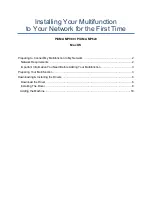Summary of Contents for VERSAMARK DP5120
Page 1: ...KODAK VERSAMARK DS5110 Printer Operator s Manual Kodak Versamark Inc ...
Page 2: ......
Page 3: ...KODAK VERSAMARK DS5110 Printer Operator s Guide ...
Page 8: ......
Page 12: ......
Page 48: ......
Page 64: ......
Page 65: ......



































